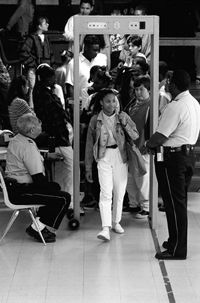 When
Chris Dunbar thinks about zero-tolerance policies, he can't help
but shake his head. The principle behind such laws is
understandable: Everyone wants safe schools. But knowing what he
knows having analyzed Michigan’s zero-tolerance law and its
implementation, Dunbar is more than a little skeptical about the
benefits of such policies.
When
Chris Dunbar thinks about zero-tolerance policies, he can't help
but shake his head. The principle behind such laws is
understandable: Everyone wants safe schools. But knowing what he
knows having analyzed Michigan’s zero-tolerance law and its
implementation, Dunbar is more than a little skeptical about the
benefits of such policies.
“Is
it a good law?” asks Dunbar, who is a faculty member in the
Department of Educational Administration. "That’s a good question.
Clearly, nobody wants to have situations where kids are bringing
weapons to school. But I think because of the expanded use of
zero-tolerance policies, kids are being expelled for reasons that
are not appropriate.
“The intent was to remove kids who posed a threat to other
students. But now it's gone far beyond that.”
Zero-tolerance policies proliferated throughout the country in the
1990s as concern about violence in the nation’s schools surged.
Michigan passed its zero-tolerance legislation in 1995; it
stipulates that if a student enters school property with such
things as a knife, gun or other type of weapon he or she is to be
automatically referred to the school board for expulsion for up
180 days.
What has led Dunbar to question the Michigan law is his research
on how principals interpret zero-tolerance policies. In the early
2000s, Dunbar teamed with his MSU colleague, Francisco Villaruel,
to conduct a study of how principals in an urban school district
in Michigan interpreted zero-tolerance policies.
They interviewed dozens of principals, querying them about their
understandings of zero tolerance and their overall approach to the
implementation of the law. The researchers found that there were
as many
interpretations of the policy as there were principals. There
appears to be no single definitive understanding or clear
knowledge of the policy's content.
 The researchers detected two broad approaches to zero tolerance.
Some principals opted to enforce the policies to the letter of the
law, referring any and all cases to the school board for
expulsion. The other approach involved the use of much more
discretion with the principal tending to consider each case
individually and then deciding whether to pursue expulsion or
another type of action.
The researchers detected two broad approaches to zero tolerance.
Some principals opted to enforce the policies to the letter of the
law, referring any and all cases to the school board for
expulsion. The other approach involved the use of much more
discretion with the principal tending to consider each case
individually and then deciding whether to pursue expulsion or
another type of action.
Dunbar remembers visiting a principal on a day when a necklace
with a replica of a gun had been found. So concerned was the
principal that she launched a schoolwide search to find the
student who had brought the chain. “That’s how serious
zero-tolerance policies were to her.”
On
the other hand, there were other principals, mostly veteran ones,
who told Dunbar that they felt children were better off in school
than out of it. So when a student brought a toy gun to school, for
example, those principals would not automatically refer the
student to the school board. Instead, they would confiscate the
toy and inform the parents that if it happened again it would be
grounds for expulsion.
Given the range in implementation of Michigan’s zero-tolerance
policies, Dunbar is convinced that there is room for abuse. In
fact, Dunbar says the research is beginning to make clear that
instead of making schools safer, the policies are becoming a handy
tool for more than a few principals to get rid of students they
consider a problem.
Zero tolerance was enacted to provide for the immediate expulsion
of any student in possession of a weapon. But over the years, the
meaning of zero tolerance has not only ranged from principal to
principal, Dunbar says, but also in terms of the instances in
which the law can be applied. Students are now being expelled for
less clearly defined offenses such as insubordination, verbal
assault, and posing a threat. He cites statistics from the Chicago
Public Schools as an example of how the use of zero tolerance has
expanded. In 1998-99, the year before zero-tolerance policies were
in place in Illinois, 14 students were expelled from the Chicago
Public Schools. In 2001, the school system expelled 1,500.
“This is what I see as one of the biggest problems with zero
tolerance,” Dunbar says. “A law that was intended to do one thing
is now doing a number of other things that it was never intended
to do. In too many instances, it has become a convenient tool to
get rid of kids. Schools can just let somebody else deal with
these kids.”
The
problem is that often there is no one dealing with the expelled
student. For Dunbar, zero tolerance appears to have removed from
the educational system the notion of rehabilitation. In Michigan,
for example, the state law makes no provision for the educational
needs of the expelled student. There is no educational
requirement, let alone counseling or other assistance to help the
student reintegrate into the educational system.
The
student is cast adrift.
Given his research [see Dunbar, C. Jr. & Villaruel, F.A. (2002).
Urban school leaders and the implementation of zero-tolerance
policies: An examination of its implications. Peabody Journal of
Education, 77(1), 82-104], Dunbar has come to the conclusion that
zero-tolerance policies on balance have only served to make a bad
situation worse. What’s more, Dunbar says such laws are
unnecessary. Principals continually told him they had always had
the power to remove a student who posed a danger to other
students. And, finally, there is no indication that zero-tolerance
policies have served to deter or reduce violence in schools. In
fact, Dunbar says the decline in school violence had started well
before zero-tolerance policies began to be enacted throughout the
country.
“All the research says that once these kids are expelled and on
the streets, they will never come back to school,” he says. “So
we’re losing children. To me, it goes against the No Child Left
Behind philosophy. We are expelling children from schools knowing
that the chances of them coming back are not very good.
“The very children we are talking about not leaving behind are, in
fact, being left behind.”

